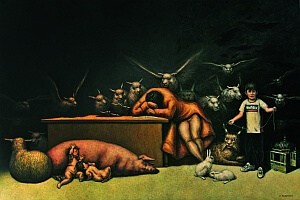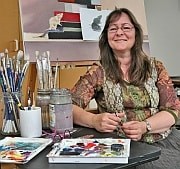As a showcase for the very best of art in the region, the Hastings City Art Gallery is our jewel in the crown, but in some ways the creative heart of Hastings can be found in the Hastings Community Arts Centre in Russell Street. Exhibitions change there every fortnight as local artists display their paintings, drawings, sculpture, photographs, ceramics, wood turning, fabric art and jewellery. Even the Live Poets perform there every month.
The number of local people who create things and show them here each year must be well up in the hundreds. Last September’s Humanities Art Classes exhibition alone showed the work of more than seventy artists and there would have been over 300 people at the opening of this show. Exhibiting work is no small deal and it takes some courage to expose your best efforts to the critical gaze of the general public.
Yes, the standard is hugely variable. I have seen some wonderful works at Russell Street and some at the other end of the scale, but that is not the point. These are extraordinary ordinary people, doing things and extending themselves. They enrich our community. In fact, part of the appeal of Russell St is that you never know what to expect there and you can be surprised and delighted by what you find.
Highlight of the year for me was Alan Baldwin’s marvellous Urewera photographs, taken some 50 years ago of some of the last kuia to wear traditionally done moko; truly a touchstone with our past. The Centre also functions as a proving ground for emerging artists who are serious about advancing themselves on a wider stage. The Community Arts Centre is eccentric, eclectic and egalitarian. It is a community treasure.
Sheer numbers make the Humanities Art Classes exhibition the biggest event of the year there and the driving force behind them is their inspirational tutor, Helen Kerridge. Her success as a teacher should not, however, overshadow her achievements as one of the better painters in our region, certainly one of my favourites. It would be easy to underrate the paintings of Helen Kerridge because they are so technically proficient. By this I mean that one could read them as no more than skilfully rendered pieces of representation, but with Kerridge there is always another layer of meaning, hinting at issues beyond the objects shown.
For example, her This is Not a Wine Glass painting in the East 2012 exhibition was prompted by empty shops and failing businesses in Hastings as local lives and hopes are affected by global failures beyond our control. It reprises a symbol from 17th and 18th century Dutch still life painters like Willem Heda in whose paintings the minor disaster of a spilled wine glass spoke of greater disasters and mortality. These pictures are better than they look! The wineglass is also a potent local marketing image and Kerridge has made tongue in cheek references in other works to Dick Frizzell’s marketing of art and wine. Frizzell, himself a master of tongue in cheek, apparently gave her a nod of approval.
Two hundred years ago the Spanish artist, Goya, made an intensely moving series of etchings and paintings portraying the violence, corruption and superstition rife in Spain at that time. Kerridge was struck by the parallels between Goya’s Spain and contemporary news events and she references his images in several works. Her painting Jason Ponders the Length of a Piece of String adapts the nightmare images of a Goya etching and the infant Romulus and Remus of a Reubens painting to respond to some of the early ethical abuses of genetic engineering. The bemused little boy watching all of this also comes from a Goya painting, but Kerridge has kiwified him from a Spanish prince into the son of one of her friends.
While Kerridge contends that the ideas behind her works are all-important, she shows a fascination with images for their own sake. Subtle nuances of light and shadow are carefully reproduced and her compositions are meticulously organised. Even the newspaper clippings shown in some works are painstakingly painted. She declines to use collage because the act of painting them provides a special point of difference.
Like most good artists Kerridge has a stubborn streak. When she studied at EIT she says “they tried to loosen me up but the more they tried the tighter I became.” So is there a danger that the stream of ideas will dry up? “No,” she says, “I just have to look in the newspaper.”
In my review of East 2012 last issue, I suggested that you could make a very decent exhibition from local artists who were not in that show. Well, off the top of my head, here are a few names that come to mind of other artists I have seen locally in the last year or so: Jill Webster, Michael Hawksworth, Ricks Terstappen, Paula Taafe, Anthony Chiappin, Ben Pearce, Chris Bryant-Toi, Sandy Adsett, Gary Waldrom, William Jamieson, Deborah Smith, Mark Smith, Freeman White, Leslie Falls and Grant Beran.
Some of these were not selected and others didn’t apply for entry and you could probably never get them all together in the same place. But it does have a healthy look about it, doesn’t it?
It also suggests that the credibility achieved by East 2012 could attract even wider participation from locally-connected artists in East 2014, which could raise it to one of the more nationally significant art events of the year.


